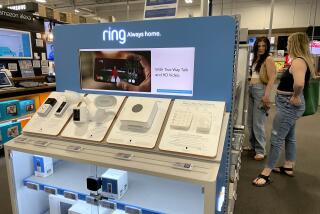USER-FRIENDLY : The Stuff You Buy Nowadays Not Only Must Function, It Has to Make You Smile as Well
- Share via
Once applied to the attempt to make computers seem as warm and cuddly as Snuggles, the fabric-softener bear, the term user-friendly describes fearsome high technology that hides behind a veneer of cuteness. If it attaches to something run by a Motorola chip, has been manufactured by a multinational conglomerate, is named after a woodland creature, and winks at you or asks you whether you would care to proceed in English or en Espanol , you can be sure that you’re dealing with a user-friendly device. Big Brother isn’t dead; he’s disguised himself as a pesky chimpanzee.
If you flip through an issue of a glossy magazine, you’ll see user-friendly products advertised in layouts that tend to resemble those announcing an oil company’s commitment to wetlands renewal or to the birth of a feel-good new missile from Northrop. When you see user-friendly stuff on TV, it practically glows, though not as much as the golden-lit spots from nuclear-weapons manufacturers that make Spielberg movies seem positively underproduced. You don’t just buy a gizmo anymore; you are welcomed to the team.
I have a certain resistance to this stuff--it’s already hard to find enough chairs at Thanksgiving without inviting into my family everybody who happens to drive the same car as my wife--but I am not immune to its charms.
My last computer was a veritable Katharine Hepburn of the computing world, brisk and efficient, charming once you got to know it but not really volunteering anything about itself unless you bothered to read the manual. My new laptop is like Sandy Duncan, relentlessly cheerful and always available, inviting you to change the blink-rate of its cursor or the configuration of the background pattern on the screen, offering to tell you the distance from Helsinki to Rio in a nanosecond or two. It greets each mistake with the appearance of an android comic-book character or the hearty quack of a duck. It cries out for math co-processors, Turbo cards and 33-MHz clock speeds, 80 million bytes of ROM and an outboard gigabyte drive. It practically begs to jack into the Internet so it can talk to its friends.
What I have on my new laptop, to paraphrase its current ad campaign, is a perky little guy who winks at me when I boot up in the morning, a couple of half-written restaurant columns, and not nearly enough of a cookbook project that was due in May.
“Essentially,” says my wife, “given a game of computer bridge here and there, this is a typewriter you’re talking about.”
But my wife is far from immune herself. In a car showroom the other day, the salesman smiled, put his finger to his lips in a shushing motion, and brought her over to a knot of salespeople in the next room who were arrayed in a circle, joining hands as if they were at any moment about to break into a hora.
“I say, I say, I say . . . Edna!” they chanted, then threw their arms in the air in a hearty cheer. Edna looked hard at her shoes. Like Edna, I wondered if it would be possible to pay a little more for the car and forgo the applause.
This is the fact I gleaned from a two-hour sales pitch: When you run this car headlong into a brick wall, the engine drops out. This, I am led to understand, is a good thing. Shopping inside a user-friendly showroom, you kind of have to pretend that you know what torque means.
While my wife and the salesman went on talking about unit-body construction and double overhead cams, I decided to wander over to the showroom’s bulletin board for the fifth time and reread the heartwarming news clippings about car owners who narrowly escaped gruesome deaths. In each and every case, the engine dropped out on cue.






